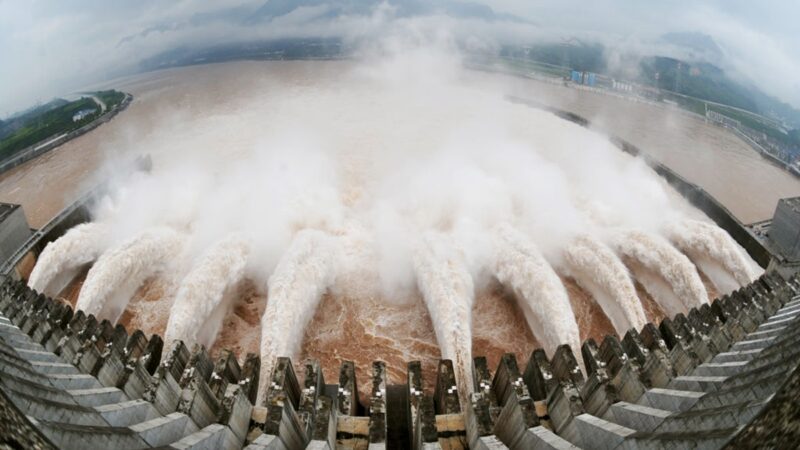On the afternoon of July 2, Typhoon Siamba made landfall in Dianbai, Maoming, Guangdong, becoming the first typhoon to land in China this year. Wherever Siamba went, violent storms raged. When Siamba made landfall, southeastern Guangdong, southern Guangxi, Hainan Island and other places continued to experience heavy rainfall at the torrential level, and local waterlogging occurred. The rainfall in Sanya City, Hainan broke a single-day historical record.
The Guangdong Maritime Search and Rescue Center reported in the early morning of the 3rd that affected by Typhoon Siamba, the anchor chain of a construction floating crane named “Fujing 001” was broken, and the anchor was lost in the waters near Hailing Island, Yangjiang, Guangdong.
As of 12:00 on July 2, 3 of the 30 crew members on board were rescued by the rescue helicopter of the Hong Kong Flying Team, and the whereabouts of the remaining 27 people are still unknown.
In addition, due to the influence of the typhoon, railway transportation in Hainan Province was temporarily suspended on the 2nd, and more than 400 flights at Haikou and Sanya Airport were cancelled. Many streets in the urban area of Sanya are flooded with water, and residents must row a boat when traveling.
On July 3, the Luquan District Government of Shijiazhuang City issued a notice saying that on the evening of July 2, due to sudden heavy rain and stormy weather, the upper part of the first archway in the north of Taitou Village, Shangzhuang Town collapsed and fell from 12 meters, causing shelter from the rain. 9 members of the crowd were crushed. At present, the authorities have rescued a total of 9 people, of which 8 were killed and 1 is being treated in the hospital.
In recent days, mainland China has been frequently hit by extreme weather. In June, the middle and lower reaches of the Yangtze River in China were affected by heavy rainfall, landslides and mudslides occurred frequently, causing many houses to collapse and many people to die.
Extreme weather not only causes casualties and regional disasters, but also seriously affects the economy. According to Chinese media reports, the heavy rainfall caused by Typhoon Siamba poses a serious threat to the production of agriculture, animal husbandry and fishery in the affected areas.
Before Typhoon Siamba made landfall, Guangdong and other southern China had been hit by heavy rainfall and floods for weeks. Many houses were destroyed and transportation was paralyzed, severely impacting people’s daily life and production activities. Affected by the heavy rainfall in mid-June, the economic loss of Xinluo District, Longyan City, Fujian Province alone exceeded 300 million yuan, more than 50 houses collapsed, and 37,571 people were affected by the disaster.
Not only do natural disasters cause damage, but in China they can also cause vulnerable groups to be further trapped in poverty.
Over the years, floods have occurred in the middle and lower reaches of the Yangtze River almost every year, and the trend is getting worse. According to the Ministry of Water Resources of the Communist Party of China, from 2010 to 2016, more than 180 cities in China were flooded or flooded each year on average.
According to public information, before 1949, the Pearl River Basin experienced an average of floods every 24 years; after 1949, floods occurred every three years; in recent years, floods occurred every year. From 2020 to 2022, Yangshuo, Guilin, Guangxi suffered floods for three consecutive years. In June this year, Yangshuo was flooded three times.
Some people believe that the main cause of flood disasters is man-made disasters, in addition to the increase of extreme weather and extreme precipitation events year by year.
The first is the inherent deficiencies and improper planning of the urban drainage system. This is mainly reflected in the low design standards and construction standards of the drainage pipe network, resulting in the overall small flow of rainwater pipes in the drainage system.
What’s more, disaster after year, these drainage systems don’t actually improve.
Second, the CCP’s excessive real estate development over the past few decades has taken up floodplains, rendering them useless as natural reservoirs. However, due to the problems of geological subsidence in the floodplain, it has also caused quality problems of the buildings built on it, and even turned into a tofu slag project.
Dr. Wang Weiluo, a water conservancy expert living in Germany, believes that the CCP has turned the “flood season” into a “flood season”, and the unwarranted flood discharge is the main reason.
There are three reasons for unwarranted flood discharge:
First, the weather forecast is inaccurate, making it impossible to accurately predict the time of the flood season and the amount of precipitation in the flood season. Furthermore, the capacity of the CCP’s reservoir is getting smaller and smaller, which makes it unable to accommodate the water volume during the flood season. The third and most important reason is that the CCP evades compensation to the people in order to throw the blame on God.
Wang Weiluo said: “If you say that I now predict that I will release the flood, then you (officially) have to compensate for all the subsequent loss of life and property, because I was affected by your flood. If You said that I was also a last resort, and if I had to release the flood urgently under the heavy rain of the old world, it would put the responsibility on the gods again, and it would not have to compensate.”
Wang Weiluo believes that the destructive power of flood discharge is far greater than that of natural floods. Flood discharge from reservoirs has caused floods in many places year after year, turning the flood season into a flood disaster period, resulting in many “once-in-a-hundred-year floods”. “Flood release without warning” has become a feature of the CCP.
“Sankei Shimbun” Taipei branch directorYaita AkioI agree with Wang Weiluo’s point of view.
